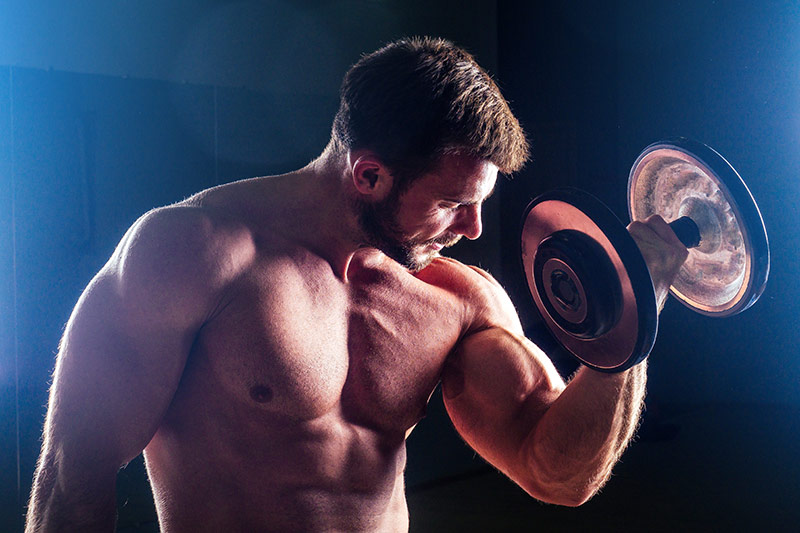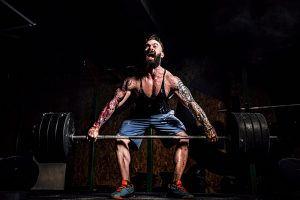We’ve all seen those huge, shredded guys in the gym that load a barbell up with so many 45lb plates that the steel bar was quivering, right? Then he lifts and squats that power bar. And you’re left wondering: how the hell is he doing that?!
Powerlifting.
Often confused with bodybuilding, which is the pursuit of a particular physique. Powerlifting is the journey to attaining as much strength as one human possibly can. It’s not always pretty, but it’s damn impressive. And you can guarantee that you’ll never struggle to move a couch or a washing machine ever again.
Intrigued? Well, this is your beginner’s guide to powerlifting and reaching incredible strength.
What is a powerlifter?

Powerlifters are dedicated to their goal: finding out how strong they can get and then pushing it to get even stronger than that. A powerlifter takes three simple exercises: the deadlift, squat and bench press and excels in every aspect.
When competing, powerlifting is the one-rep max of a squat, bench press and deadlift. You’ll get three attempts at each to lift your max weight. Add together your highest weights from each exercise, and that’s your powerlifting total.
But we’re jumping in at the deep end here. All beginners really need to know is that powerlifting is just lifting weights to get stronger. And that once you start, it’s almost intoxicating. Powerlifters often develop an almost mystical sense in their training journey because they’re existing at the edge of their physical limits.
Powerlifting is no joke. There’s no faking it. It’s demanding and incredibly taxing on you both physically and mentally. Anyone who’s deadlifted 500lbs is some kind of superhuman. So, if you’re looking for the ultimate challenge to test yourself and your strength, then powerlifting could be your next journey.
Also Read: How to get bigger legs
It’s not just about picking up and putting down heavy things. There’s a lot to learn: breathing, bracing, rooting, optimal foot and bar positions, activation, head position, gaze. But getting physically strong teaches you a lot about your body and your character.
Four reasons you should start training as a powerlifter

Need a bit more convincing about whether or not powerlifting is for you? Here are four reasons you should begin training as a powerlifter.
Strength = everything
How often have you heard someone say, oh, I wish I wasn’t so strong, I wish I could carry less groceries from the car, I wish I needed help moving the dryer. Yeah, never. Strength is one of the most valuable investments you can make in yourself.
Increased Mental Toughness
Just like running a marathon is an endurance battle against your lungs, powerlifting requires a tough mental state. Training as a powerlifter pushes you to your absolute limits.
Train safely
Under the trained eye of a good coach and using the proper prep, the average injury rate is far below those in other sports like soccer or basketball. Plus, according to recent research, powerlifting has been shown to decrease the risk of osteoporosis.
There’s no age limit
In many other sports (and even in life), players are considered ‘old’ by the time they’re 30. In contrast, powerlifters are typically at their strongest at 35-40 years old.
As with any athletic pursuit, as time goes on, making gains will require more effort and dedication. Anything worth doing takes time and focus, and the road to 90% is relatively easy. However, increasing from 90% to 100% is where it requires real drive.
What do you need to begin powerlifting?

It all begins with technique. And whilst powerlifting is primarily based around these three movements, they’re much more technical than people give them credit for. So, before you rush into adding plates to a barbell, get the technique down and get comfortable with those movements first.
An air squat mimics a squat, a pushup mimics a bench press – so if you’re not sure where to start, begin powerlifting by mastering these two movements.
As you work on your technique, move to an empty barbell and do 3-5 reps sets. Those starting out should bench and squat 2-3 times a week and deadlift once a week. Work your way up slowly by adding a little bit more weight each week. But always remain focused on your technique and aim to try to get better and more efficient.
Also Read: Should you bulk or cut?
If you’re serious about training as a powerlifter, then choosing a gym is a crucial step. Opt for a powerlifting-friendly gym, not only because it gives you the freedom to take your time at the different weight stations but because you’ll also be able to watch and learn from more advanced powerlifters and coaches at your gym.
Not sure where to start? Look at USA Powerlifting’s gym search tool for your nearest powerlifting gym.
To begin with, you won’t need too much gear. Powerlifters often wear specific powerlifting shoes that offer a solid, slightly raised heel that helps lifters get into a better position under the barbell whilst engaging their posterior chain. For deadlifting, just go for something with a thin heel like a pair of converse or deadlifting slippers. This will reduce your range of motion whilst maximizing your foot’s connection with the floor.
Many powerlifters invest in specialized equipment like knee sleeves and lifting belts, but you can hold off on these until you’ve seriously committed to powerlifting.
Popular safe and legal steroid alternatives
Avoiding beginner powerlifting mistakes

- Work your way up, and don’t start too heavy. Too many people give up on something because they’ve not checked their ego and tried to lift too heavy. Educate yourself on form and technique before getting under a barbell.
- Stay disciplined and focused. If you’re going to start training as a powerlifter, then stay focused. Don’t split your energy and focus by also playing soccer or signing up for a marathon at the same time. You’ll not only make it so much harder for yourself, but you risk injury too.
- Pay attention to your body and pain. Any kind of workout is going to leave you feeling a little sore. But pain is a warning sign to rest and take time to recover, don’t push through it and risk injury unnecessarily.
- Rep or do not rep. This comes back to form and technique; every gym has a guy who insists he can squat 500lbs and then does the worst half-rep you’ve ever seen. Make sure you’re working through a full range of motion when starting, and then work your way up through the weights.
- A good coach or trainer is gold. As a beginner powerlifter, you’ll benefit amazingly from having a coach or trainer who can plan out your training and show you the best ways to work and build your gains. A coach can also advise you on the best eating plan to increase your strength and hit your goals.
- Use chalk. It’ll help your grip when you’re deadlifting and improve the tightness of your squat.
Training plan for a beginner powerlifter
If you’re stuck where to start, then our training plan for a newbie powerlifter will help you get started. It consists of three workouts a week, with each gym visit seeing a weight increase. This allows you to make huge gains and progress with 1-1.5 hours of lifting, three times a week.
Although it doesn’t sound like much, powerlifting workouts are all about big, compound movements. So, this training plan challenges your musculature and your central nervous system, paving the way for gains without overworking your body.
Warming up as a powerlifter

A good warmup will leave you feeling ready to go and your muscles adequately prepared for what’s to come.
Do three rounds of the following to warm up:
- 10 air squats
- 10 good mornings
- 10 Romanian deadlifts
- 10 pushups
- 10 pullups (can scale down to ring rows if necessary)
- 15-20 seconds of hip stretching like clamshells
How to establish your benchmark weights
On your very first day as a powerlifter, you’ll be establishing your benchmarks in bench and squats. Rather than working out your maximum, you want to work out your comfort zone and build from a solid foundation. From here, you’ll increase your weights each session.
Once you’re warmed up, do ten reps of squats and bench with an empty barbell (45lbs). From there, increase the weight of each set by 5-25lbs, depending on what feels comfortable for you. Your ultimate goal is to settle at a weight you can lift for eight reps, but it’s not your max. You should have another three reps in you.
Also Read: How to strength train while cutting
Remember to rest for 3-5 minutes between each set.
Powerlifter Training plan

Monday:
Warmup
Squat: 3 sets of 8 reps
Bench: 3 sets of 8 reps
Your row of choice (seal row, pullups, bent-over rows): 3 sets of 10 reps
Planks: 3 rounds for max time
Wednesday:
Warmup
Squat: 3 sets of 8 reps
Overhead press: 3 sets of 10 reps
Romanian deadlift: 3 sets of 10 reps
Saturday:
Warmup
Squat: 3 sets of 8 reps
Bench: 3 sets of 8 reps
Deadlift: 2 sets of 5 reps (Start 15 lbs heavier than your starting squat weight.)
Single-arm Row: 3 sets of 12 reps
Increase your weight each training session:
Squat and deadlift: 10lbs each session, and once it starts to get challenging, increase by 5lbs.
Bench press and overhead press: 5lbs and then by smaller amounts once it starts to feel challenging.
Our final tips and tricks for beginner powerlifters
- It really does all start with your form and technique. Imagine powerlifting to be like a golf swing, and you’re working on the repetition of that swing to perfect it over time. By repeating the same movements, you’ll get better, more efficient, and able to lift increasingly heavier weights.
- Do your research like you would any new sport or hobby, to be well informed will help you on your journey to becoming a powerlifter.
- Find a coach to work with; they’ll help you make gains so much quicker than you can do alone. Plus, they’ll ensure that you’re performing in a safe way that limits injury.
- Don’t forget about adequate nutrition to support your goals. Eating right and choosing supplements that support your gains will help you up your game.
Supporting you and your powerlifting goals

Alongside a comprehensive training schedule and a foolproof nutrition plan, our 100% natural and safe steroid and SARMs alternatives can help you build muscle and increase your strength in no time, with NO side effects.
With our range of natural steroids and SARMs alternatives, get ready to gain muscle, enhance your performance and reduce your recovery time!
















